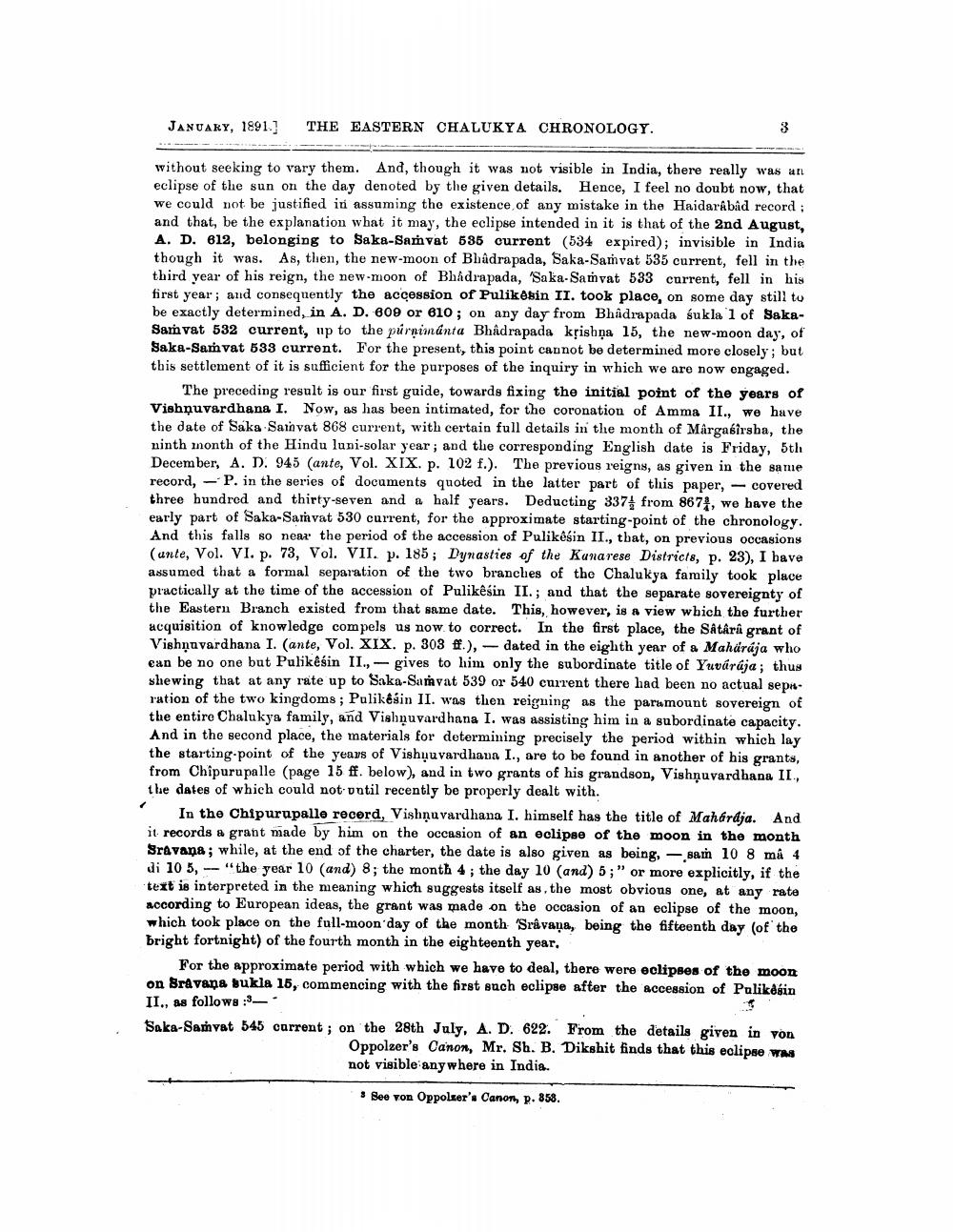________________
JANUARY, 1891.)
THE EASTERN CHALUKYA CHRONOLOGY
without seeking to vary them. And, though it was not visible in India, there really was an eclipse of the sun on the day denoted by the given details. Hence, I feel no doubt now, that we could not be justified in assuming the existence of any mistake in the HaidarAbâd record ; and that, be the explanation what it may, the eclipse intended in it is that of the 2nd August, A. D. 612, belonging to Saka-Samvat 535 current (534 expired); invisible in India though it was. As, then, the new-moon of Bhadrapada, Saka-Samvat 535 current, fell in the third year of his reign, the new-moon of Bhadrapada, "Saka-Samvat 533 current, fell in his first year; and consequently the accession of Pulikekin II. took place, on some day still tu be exactly determined, in A. D. 609 or 610; on any day from Bhadrapada sukla 1 of SakaSamvat 532 current, up to the purnimánta Bhadrapada krishņa 15, the new-moon day, of Saka-Samvat 533 current. For the present, this point cannot be determined more closely; but this settlement of it is sufficient for the purposes of the inquiry in which we are now engaged.
The preceding result is our first guide, towards fixing the initial point of the years of Vishnuvardhana I. Now, as has been intimated, for the coronation of Amma II., we have the date of Saka Saivat 868 current, with certain full details in the month of Margasirsha, the ninth month of the Hindu luni-solar year; and the corresponding English date is Friday, 5th December, A. D. 945 (ante, Vol. XIX. p. 102 f.). The previous reigns, as given in the same record, - P. in the series of documents quoted in the latter part of this paper, covered three hundred and thirty-seven and a half years. Deducting 337 from 8674, we have the early part of Saka-Samvat 530 current, for the approximate starting-point of the chronology. And this falls so near the period of the accession of Pulikesin II., tbat, on previous occasions (unte, Vol. VI. p. 73, Vol. VII. p. 185; Dynasties of the Kanarese Districts, p. 23), I have assumed that a formal separation of the two branches of the Chalukya family took place practically at the time of the accession of Pulikesin II. ; and that the separate sovereignty of the Eastern Branch existed from that same date. This, however, is a view which the further acquisition of knowledge com pels us now. to correct. In the first place, the Satârâ grant of Vishnuvardhana I. (ante, Vol. XIX. p. 303 #f.), - dated in the eighth year of a Maharaja who ean be no one but Pulikêśin II., - gives to him only the subordinate title of Yuvárája; thus shewing that at any rate up to Saka-Sarvat 539 or 540 current there had been no actual sepatration of the two kingdoms; Pulikesin II. was then reigning as the paramount sovereign of the entire Chalukya family, and Vishņuvardhana I. was assisting him in a subordinate capacity. And in the second place, the materials for determining precisely the period within which lay the starting point of the years of Vishụuvardhana I., are to be found in another of his grants, from Chipuru palle (page 15 ff. below), and in two grants of his grandson, Vishņuvardhana II., the dates of which could not until recently be properly dealt with.
In the Chipurupallo record, Vishnuvardhana I. himself has the title of Mahárája. And it records a grant made by him on the occasion of an eclipse of the moon in the month Sravana; while, at the end of the charter, the date is also given as being, sam 10 8 má 4 di 10 5, -- "the year 10 (and) 8; the month 4; the day 10 (and) 5;" or more explicitly, if the text is interpreted in the meaning which suggests itself as, the most obvious one, at any rate according to European ideas, the grant was made on the occasion of an eclipse of the moon, which took place on the full-moon day of the month Sråvaņa, being the fifteenth day (of the bright fortnight) of the fourth month in the eighteenth year,
For the approximate period with which we have to deal, there were eclipses of the moon on 8ravana sukla 16, commencing with the first such eclipse after the accession of Poliksin II., as follows: Saka-Samvat 545 current ; on the 28th July, A. D. 622. From the details given in von
Oppolzer's Canon, Mr. Sh. B. Dikshit finds that this eclipse WMS not visible anywhere in India.
See von Oppolzer': Canon, p.858.




